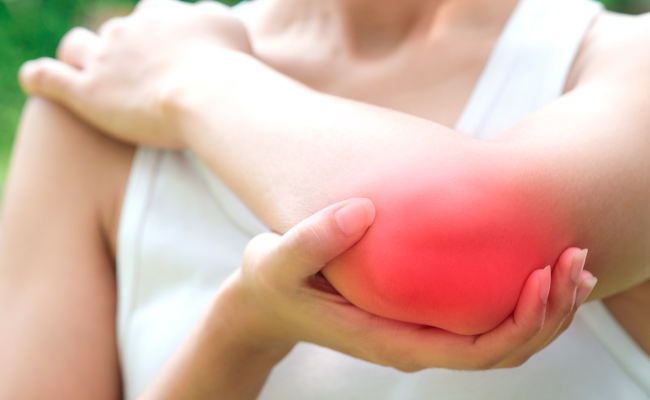How to Treat Bursitis?
- November 28, 2023
- No Comments

What is Bursitis?
Bursitis, a painful condition, impacts the small, fluid-filled sacs known as bursae that serve as cushions for bones, tendons, and muscles around joints. These sacs play a crucial role in reducing friction, providing a smooth gliding surface during movement. However, when inflammation occurs in the bursae, leading to the development of bursitis, discomfort arises. This condition is frequently observed in joints subjected to repetitive motions, including the shoulders, elbows, hips, and knees.
The onset of bursitis is linked to the irritation and swelling of a bursa. Excessive use and undue pressure on the bursa are the primary triggers for this condition. The pain associated with an inflamed bursa can either emerge suddenly or gradually intensify over time. Essentially, bursitis is a consequence of the strain imposed on these protective sacs, resulting in discomfort and swelling in the affected areas.
Why Does Bursitis Occur?
Bursitis can result from various factors, with the most common being repetitive movements or overuse of a joint. Additionally, it can be caused by injury, trauma, or infection. The bursae can become irritated and inflamed, leading to pain, swelling, and limited range of motion in the affected joint. Age, certain medical conditions like rheumatoid arthritis, and occupations or hobbies that involve repetitive motions can increase the risk of developing bursitis.
How to Identify Bursitis?
Identifying bursitis involves recognizing specific symptoms and understanding the factors that may contribute to its development. Common signs of bursitis include localized pain, swelling, and tenderness around the affected joint. The pain may worsen with movement or pressure on the area. In some cases, the joint may feel warm to the touch, and there may be redness. If you suspect you have bursitis, it's crucial to consult a healthcare professional for a proper diagnosis.
Treatment Solutions for Bursitis
- Rest and Activity Modification: One of the primary treatment approaches for bursitis is to allow the affected joint to rest. This may involve avoiding activities that exacerbate the pain and modifying your daily routine to reduce stress on the joint. Rest is essential for the inflammation to subside and the healing process to begin.
- Ice and Heat Therapy: Applying ice packs or cold compresses can help reduce swelling and alleviate pain associated with bursitis. Cold therapy is particularly effective during the initial stages of inflammation. Conversely, heat therapy, such as warm compresses or hot baths, can promote blood circulation and ease muscle tension, providing relief in later stages of recovery.
- Nonsteroidal Anti-Inflammatory Drugs (NSAIDs): NSAIDs, like ibuprofen or naproxen, are commonly used to manage pain and inflammation associated with bursitis. These medications can be obtained over-the-counter but should be taken under the guidance of a healthcare professional. It's important to follow the recommended dosage and duration to avoid potential side effects.
- Physical Therapy: Physical therapy plays a crucial role in the treatment of bursitis by focusing on exercises that strengthen the muscles around the affected joint, improve flexibility, and enhance overall joint function. A physical therapist can tailor a specific rehabilitation program to address the individual's needs and help prevent future occurrences of bursitis.
- Corticosteroid Injections: In cases where pain and inflammation persist, healthcare providers may administer corticosteroid injections directly into the affected bursa. These injections can provide rapid relief by reducing inflammation. However, they are typically used judiciously due to potential side effects, and their use may be limited to a few times per year.
Benefits of Bursitis Treatment:
- Pain Relief: The primary benefit of treating bursitis is the alleviation of pain associated with the condition. Rest, medication, and other interventions work together to reduce inflammation and discomfort, allowing individuals to resume their daily activities with greater ease.
- Improved Joint Function: Treatment measures, especially physical therapy, contribute to improved joint function. Strengthening the surrounding muscles, enhancing flexibility, and restoring proper movement patterns aid in the recovery process and reduce the likelihood of recurrent bursitis episodes.
- Prevention of Complications: Untreated bursitis can lead to complications such as chronic inflammation, infection, or the development of calcium deposits in the affected area. By promptly addressing the condition, individuals can prevent these complications and promote long-term joint health.
- Enhanced Quality of Life: Managing and treating bursitis positively impact an individual's quality of life. The reduction in pain and improvement in joint function allow for greater mobility and participation in daily activities, work, and recreational pursuits.
- Avoidance of Surgical Intervention: In many cases, non-invasive treatment methods effectively manage bursitis, eliminating the need for surgical intervention. By addressing the condition early and following a comprehensive treatment plan, individuals can often avoid more invasive measures.
Comments (0)